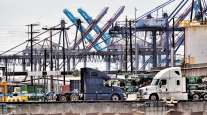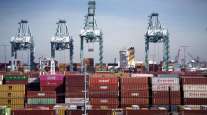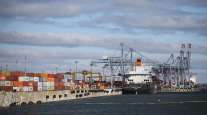Senior Reporter
Ports Off to Strong Start in 2018, but Expansion Needed, Experts Say

Ports across the United States are shattering monthly and yearly records for the amount of cargo being shipped, and transportation industry experts say the trend likely will continue as the U.S. economy remains on a steady pace.
In the first two months of 2018, container tonnage at the Port of Houston increased 7% as 6.1 million tons of cargo were processed.
The Port of Los Angeles had the busiest February in its 111-year history, and the Port of Long Beach, Calif., reported a 32% increase in February from the same time in 2017.
In Jacksonville, Fla., Jaxport said container volumes are up 25% in 2018 compared with a year ago.
The Port Authority of New York and New Jersey reported a cargo record in February and that it is on track to improve upon the record set in 2017, when it handled 6.7 million 20-foot-equivalent units, or TEUs, for the entire year.
“We are starting the year off very strong, and that’s encouraging,” Port Authority of New York-New Jersey Deputy Director Sam Ruda said. “We’ve been on a very good run here.”

North Jersey Transportation Planning Authority
Even during the Great Recession, many ports started planning significant infrastructure and other improvements, anticipating a jump in cargo. One reason is that in 2007 Panama began a $5.2 billion expansion, doubling the capacity of the Panama Canal. That allowed it to handle the world’s biggest Neopanamax ships, carrying as many as 15,000 containers each.
Beginning in 2016, and through 2020, U.S. ports plan to spend an estimated $155 billion in public and private sector funding on infrastructure-related projects. Numerous ports are in the middle of extensive dredging projects, adding more massive cranes, and new berths, along with widening access roads to improve the connections from the dockside to the highway on-ramps.
The New York-New Jersey Port Authority is spending $4 billion for ongoing terminal improvements and several cranes that are scheduled to arrive this month. Last year it completed raising the roadway of the Bayonne Bridge by 50 feet, without taking the bridge out of service. The span connects Bayonne, N.J., and Staten Island. The additional height means the port authority can accommodate much larger ships, and there is future expansion for cars and trucks.
“The ports are really playing catch-up in some cases to make sure there is sufficient capacity to handle cargo that gets concentrated, Hackett Associates economist Paul Bingham said. “With larger size vessels, you have more cargo on and off one ship at a time, which means instead of having two ships with the same capacity as one larger ship, you concentrate the cargo. Instead of spreading it out with two vessel calls, it’s one.”

New Jersey Transportation Planning Authority
For now, the ports and dray truckers are holding their own regarding moving cargo by operating more efficiently. But officials caution many ports may be about to reach the physical limits of their capacity to expand.
“If you can cut the average dwell time of a box, cut it in half, you’re doubling the capacity of that terminal without building a single piece of physical infrastructure,” American Association of Port Authorities CEO Kurt Nagle said. “So, more and more that’s where we are going to have to see those gains in terms of capacity and efficiency.”
Incremental progress is being made at some ports to make them more efficient and reduce the amount of time that cargo sits before it is loaded onto trucks. Oakland, Calif.-based Pacific Merchant Shipping Association reported that from December 2017 to the end of February, the average number of days a container stayed at the ports of Los Angeles and Long Beach dropped 16%, from 3.08 days to 2.63 days.
Time is money. For trucking companies and shippers, the increasing cargo volume is doing more than generating more revenue for everyone along the supply chain. It also is forcing port authorities and others to look at their expansion plans, five and 10 years out, and consider moving some operations off-property, and constructing larger terminals for trucks and rail, up to 100 miles away. This move could cut the need for drivers to enter congested ports, cutting their waiting and shortening their trips.
“We are seeing a huge amount of interest in industrial real estate around the ports, and anywhere in the metro area,” Ruda said. “There are multiple ways of adding capacity, instead of just adding more land to, at a minimum, double our volume growth, and that will have a long-term impact on our facility design. You have got to plan for volume growth.”




